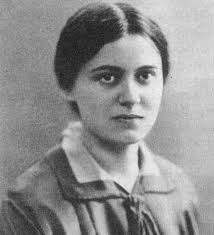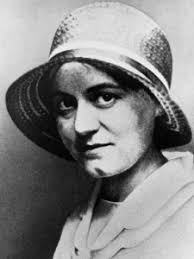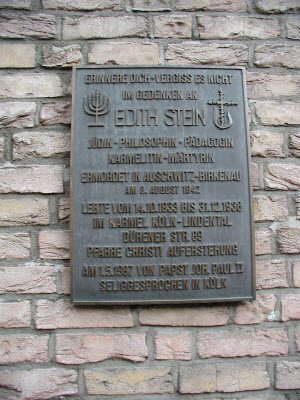This essay was originally published on the UI Women’s Center blog. My comment on chromosomes was not allowed in the original publication.
Writing for this blog has opened me up to new thoughts and ideas. I am challenged to think critically about the issues surrounding women and humanity as a whole. I am a believer that in order to find solutions to problems, definitions are needed. What is woman? I told myself, “I know what it is to be a woman, at least I know that I am one.” Besides confirming my gender by my XX chromosomes, I wanted to know what it means to be a woman from a philosophical point of view.
I recently went to a lecture about the nature of woman and was introduced to the works of Dr. Edith Stein. She was an early 20th century philosopher whose research focused on women, empathy, and “feminine” traits. As I researched her life and read her lectures, I found the explanation to what I hadn’t been able to put into words before.
The Jew, the Atheist, and the Believer

Stein was born in in 1891 in Breslua, Germany, which is now in modern-day Poland. She was the youngest of eleven children and her parents were devout Jews. She was very close to her mother and was considered her favourite. Life circumstances, including the death of her father, led her to become an atheist by her teens. “I consciously decided, of my own volition, to give up praying.”
Stein was academically brilliant, studying German and history at University of Breslua, and later philosophy at Gottingen University. She was particularly interested in women’s issues and was a self-described radical suffragette. The subject of women in a professional setting and religious living became her focus later on in life. In 1915, she served as a nurse in WWI, where she was deeply disturbed by the sickness and death she witnessed. After a year, Stein returned to school and earned her doctorate summa cum laude with her thesis “The Problem of Empathy.”
Then came her encounter with her faith. While in Frankfurt, she and a friend stepped inside the Frankfurt Cathedral to admire its architecture. There she saw a woman kneeling on the floor surrounded by shopping bags.
“This was something totally new to me. In the synagogues and Protestant churches I had visited, people simply went to the services. Here, however, I saw someone coming straight from the busy marketplace into this empty church, as if she was going to have an intimate conversation. It was something I never forgot.”
After this event she went on to meet others who would solidify her beliefs. Stein was baptized into the Catholic Church on January 1, 1922.

Essays on Woman
Stein petitioned for professorship many times, rejected first for being a woman and later for being a Jew. Even though she had converted to Christianity, Judaism is regarded as an ethnic identity as well as a religion that can be passed down through generations. During WWII, the Nazis used this to persecute many who did not practice Judaism but still came from a family that had a history of Jewish affiliation. This did not stop her from continuing to write about the women’s roles in and out of the workplace.
“The experience of recent years has shown that in addition to those professions which have been recognized traditionally as feminine, other professions must be opened up to woman if she is to perform the service of helping other persons to become complete human beings. Quite outside of her professional activity, in no matter what sphere of life she finds herself, woman can direct her efforts to furtherance of total humanity. She finds opportunity to influence others, no matter where she meets them, through her active interest and her own example.”
At a time when women’s views where not always seen as equal, Stein found a safe haven in the Catholic Church. She was encouraged by many to speak her mind on issues that affect women as women. Her biggest contribution to the philosophy community, which has at times not been as welcoming to women, was her collection Essays on Woman. Edith aimed to define the “soul” of women, and explored “masculine” and “feminine” gifts, writing,
“Woman’s intrinsic value consists in the ability:
- To become a complete person oneself;
- To help others to become complete human beings;
- To respect the complete human being.”
That is to say, from a philosophical standpoint, that women, and all human beings for that matter, have value simply because we can grow in becoming better versions of ourselves, can help others in this goal, and can in turn see the value in others.

In terms of vocation, or one’s calling in life, Stein writes that women should not limit themselves to only “feminine” work.She proposes that with this, women can have the elevated “gifts” of receptivity, sensitivity, generosity, and maternal instincts, and many others. These gifts can be used in the quest to become a complete human being. That is not to say that women who do not have these gifts are not real women, or that others besides women cannot have some of these attributes as well. What she is saying is that in order to grow in oneself as a woman, one must recognize “feminine” virtues in relation to “masculine” virtues. “The same gifts occur in both [men and women], but in different proportions and relation.”
“It would not be difficult to mention women in the most diverse professions who have achieved excellence, but this would not prove that their occupations were specifically feminine ones. Not every woman is a pure embodiment of feminine nature. Individualities are not simply variations of feminine nature but are often approximations of masculine nature and qualify, thereby, for an occupation not regarded as specifically feminine.”
For Edith, the ultimate example of human being is Christ, and in him “the masculine and feminine virtues are united, and their weaknesses redeemed.” When women grow in their awareness in one’s self, their femininity is embraced and reconciled, and they grow in masculine gifts as well. Stein maintains that while keeping the distinction between what is feminine and what is masculine, unification of these virtues is necessary to be “complete.”
I understand that not everyone believes in God, is religious, or Catholic, but for me, Edith helped me discover my own “womanhood.” Her work spoke to me and inspired me to reevaluate my attitudes towards femininity, and has helped me to recognize my gifts to the world, both feminine and masculine. I invite you the reader to explore this aspect of yourself. Ask yourself: what makes me what I am? What makes me valuable? What do I have to offer to the world? Always keep searching for the Truth and when it is revealed, grasp on to it and never let go.
Death and Legacy

Edith Stein became Sister Teresa Benedicta of the Cross on April 21, 1938 when she entered into the Carmelite Order. She continued to write and hold lectures amidst the increasing despair of WWII. Because of growing anti-semitism, Sister Teresa Benedicta and her older sister Rosa were smuggled into the Netherlands.
On July 20, 1942, the Dutch Bishops’ Conference read a public condemnation of the Nazis and their treatment of Jews. In retaliation, the Nazis order all Jews who had converted to Christianity in the Netherlands to be arrested. Sister Teresa Benedicta, along with Rosa, were taken to Auschwitz on August 7th.
She told her sister calmly, “Come, we are going for our people.”
She died on August 9, 1942. Today Edith Stein is known as Saint Teresa Benedicta of the Cross, philosopher and phenomenologist, martyr and Daughter of Israel.
